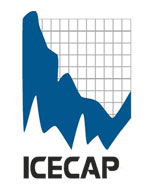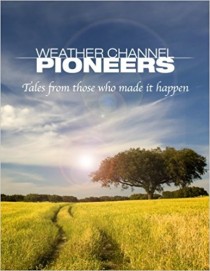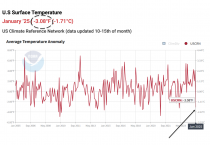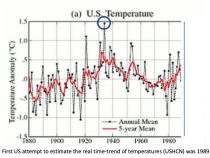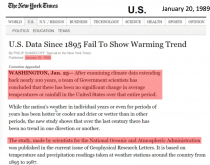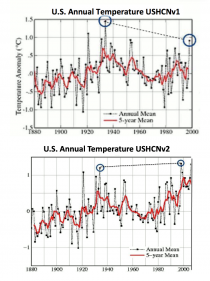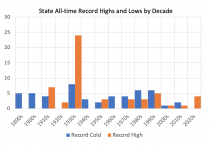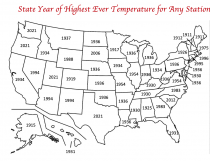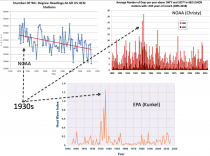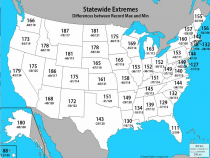January Anomalies for the USHCN (US Climate Reference Network) - US averaged 3.08F below normal, among the top 10 coldest in the records.
The U.S. Climate Reference Network (USCRN) is a systematic and sustained network of climate monitoring stations with sites across the contiguous U.S., Alaska, and Hawaii. These stations use high-quality instruments to measure temperature, precipitation, soil conditions, and more. USCRN provides a continuous series of climate observations to monitor national climate trends and support climate-impact research.
The network is much less subject to local Urban Heat Island elevating night-time readings. Ironically, the first Climate Data Center knew this and attempted to adjust for UHI.
NOAA National Climate Data Center Director Tom Karl’s paper in 1988 defined the UHI adjustment for the first version of USHCN:
“… trends of surface air temperature computed predominantly from urban station data are likely to have a serious warming bias… 0.34C/decade (about 6F/century)… The rate may have increased after the 1950s, commensurate with the large growth in and around airports (up from 20% to over 70%)” Karl 1988.
“Our results and those of others show that this ‘growth’… is serious and must be taken into account ...assessing temperature...”
The first ever monthly US plot with the adjustment looked like this.
The NYT noticed a lack of warming in the data (1989 was just after Hansen’s 1988 congressional ‘show’ with AC off and windows open in the 1988 heat wave).
We in the forecasting industry (I was at TWC still in 1989. JB at ACCU) knew about UHI.
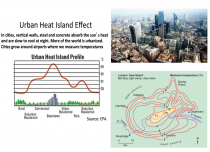
Listen to most any forecast on TV and radio and you will see or hear something like this.
“Low tonight near 40 in town but some upper 20s in the rural cold spots. High tomorrow in the mid 50s”.
That is the UHI story
Some at NASA illustrated the issue with ignoring UHI.
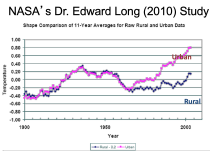 \
\
Enlarged
Inexplicably, the UHI adjustment Karl argued for was removed in USHCNv2 over decade later.
The state all-time records clearly show the 1930s as the hottest decade from the records (not adjusted for UHI)
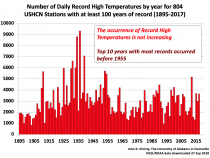
Enlarged
The UHI warming is mostly at night. The range for all stations from warmest ever to coldest ever is well above 100F.
(1) History shows that mortality is 20 times greater for cold than warm for 13 major countries in all climate zones.
(2) Heat records are not increasing. Heat was a far worse problem a century ago.
(3) Multi-decadal cycles of warming and cooling can be explained by solar and ocean cycles and/or volcanism. Much of the apparent warming shown in global surface data constructions relate to urban heat island effect, which elevates nighttime lows. Data sites designed to avoid contamination show no warming since their inception more than 16 years ago.
(4) Cold temperatures have a far greater negative economic impact than warmer conditions. See more here.
(5) The overestimation of greenhouse warming and heat related mortality can be attributed to poor modeling
See more details in this report.
------------------------
Please SUPPORT ICECAP if you can with the Paypal link on the left. We working to update our case that climate changes can be explained by natural cycles and that these same factors can be used to predict ahead with more skill than the models. I have been doing that since first inspired by my heroes like Jerome Namias. ln my lifetime, I have witnessed and spent a career explaining what was behind the weather regimes. In the 1950s, we were worried about heat and hurricanes, in the 1970s even Mr Spock was doing shows on the coming ice age. Since the 1990s we have been told heat would get us and we would be underwater in NYC by the 2020s.
I am sure you have been shocked by the wacky weather the last few years including the historic snowstorm on the Gulf coast. I have spent my career trying to understand what factors explain the cycles to get a leg up on forecasting what is ahead. Icecap has been a one man show with contributing posts from some of my former students and friends. We have reached 282 million page views. Our library and search engine is searchable with well over 10,000 entries. We have lost many of my career associates the last 10 years. Many of these giants in our field can be found in our library. As I have moved away from some of my daily efforts I hope to find partners to take the work we have done and build the future ICECAP. Contact me at jdaleo6331@aol if you have ideas or questions.
